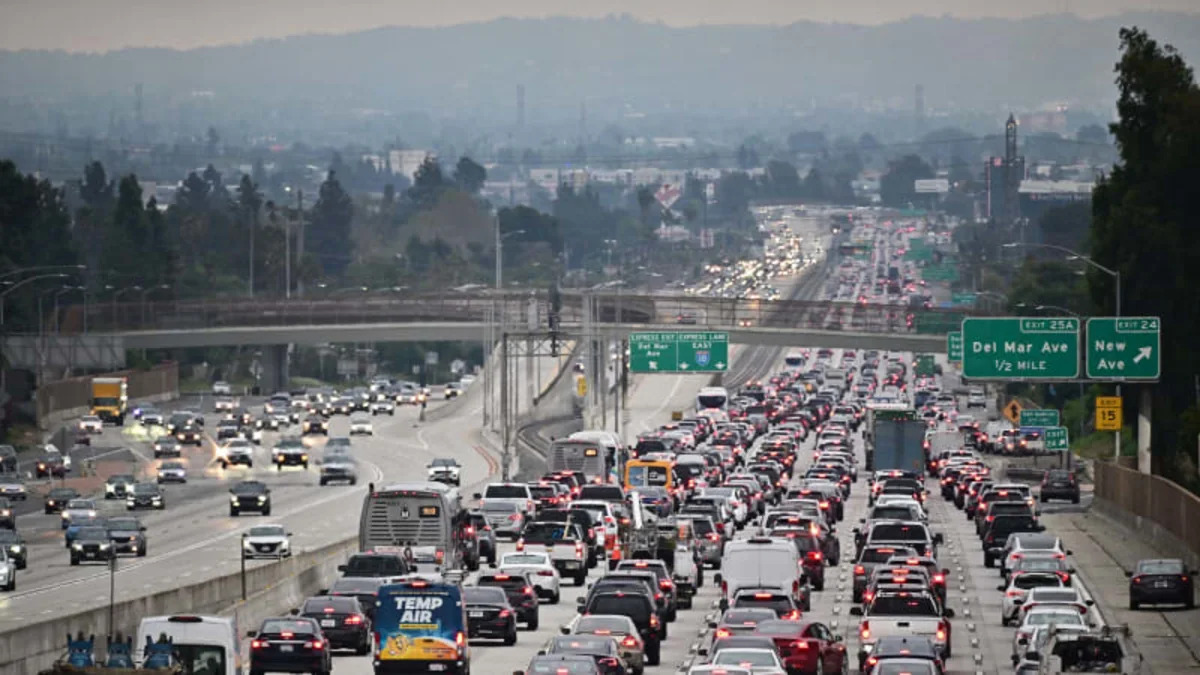A new study finds that California’s electric vehicle rebate program is resulting in cleaner air, but wealthier communities so far are reaping most of the benefits.
Researchers at the University of California at Berkeley, the University of North Carolina at Chapel Hill and the University of Miami analyzed the geographic distribution of more than 400,000 rebates issued in California since 2010 for the purchase of electric vehicles. They then modeled estimated emissions of carbon dioxide, nitrogen oxide and sulfur dioxide, as well as PM 2.5 — particulate matter 2.5 micrometers and smaller that’s found in vehicle exhaust and power plant emissions. Scientists have linked exposure to PM2.5 with heart and lung disease and 7 million premature deaths globally each year.
California’s EV buyers can obtain state rebates worth as much as $7,500, even before any federal incentives allocated as part of the Inflation Reduction Act. But communities that California classifies as disadvantaged received only 7% of the state incentives between 2010 and 2021, according to the peer-reviewed paper published Wednesday in the journal PLOS Climate. Communities ranked as “least disadvantaged” claimed 46% of the rebates
Residents in better-off areas are also breathing easier: PM2.5 emissions fell a median of nearly 0.7 kilograms per year in those census tracts, four times the median reduction in disadvantaged communities. Researchers found that PM2.5 pollution actually rose in 17% of disadvantaged areas, which are home to 39% of California’s fossil fuel power plants. Those communities also experienced smaller reductions in other air pollutants in contrast to wealthier areas, according to the analysis of 8,057 census tracts in California.
“These communities receive far fewer rebates and therefore see substantially less air quality improvement as a result of decreased tailpipe emissions,” said Jaye Mejía-Duwan, the study’s lead author and a PhD student in UC Berkeley’s environmental science, policy and management program. Mejía-Duwan said low-income neighborhoods often bear the brunt of increased power plant pollution that results from charging EVs located in distant wealthier areas.
California in 2016 revamped its rebate program to limit participation by high-income households – currently those earning more than $200,000 – and expanded refunds from $2,000 to now $7,500 for lower-income residents. However, the researchers determined those changes have had only a marginal impact on the distribution of incentives to disadvantaged communities.
A University of Southern California study released in February also found a correlation between the growing numbers of electric vehicles on the road in California and healthier air. An analysis of 1,238 ZIP codes showed that 20 EVs per 1,000 residents was associated with a 3% decline in asthma-related visits to emergency rooms.
“This study really provides the first real-world evidence that switching to zero-emission vehicles can be this win-win of getting reductions in greenhouse gas emissions but also improving local air quality and health,” said Erika Garcia, lead author of the USC paper and an assistant professor of population and public health sciences at the university’s Keck School of Medicine.
USC researchers also analyzed nitrogen dioxide data from US Environmental Protection Agency air quality monitoring sites. They found only a slight decrease in NO2 emissions — 0.41 parts per billion, on average — in the 95 zip codes equipped with air quality sensors, which tend to be placed in lower-income areas to measure air pollution from power plants, vehicles and other sources. Garcia said the small number of air quality monitors was a limitation in the study, but described the minuscule NO2 emissions decrease as evidence that leaving disadvantaged communities out of the EV transition is “an environmental justice issue.”
The more recent rebate study makes clear that electric vehicles are not a panacea when it comes to PM2.5 pollution, as overall particulate emissions increased in California. That’s because while EVs eliminate tailpipe PM2.5 emissions, they can throw off more particles from tires and brakes due to the weight added by heavy battery packs.
The trend in the U.S. toward bigger and more expensive electric vehicles – General Motors last month announced it was ceasing production of its compact Bolt EV to build large electric trucks – could worsen that pollution, according to researchers. One 2020 paper issued by the Organization for Economic Cooperation and Development found that lighter weight electric cars with a range of 100 miles reduced non-exhaust PM2.5 emissions 11% to 13% compared to fossil fuel-powered vehicles. But heavier 300-mile range EVs increased non-exhaust particulate emissions 3% to 8%.
“The increase in overall particulate matter emissions in California is a result both of the high emissions rates of particulate matter from electric vehicles as well as from the increased particulate matter emissions from power plants to supply demand from all the new electric vehicles on the road,” said Mejía-Duwan.
The study’s authors recommended further adjustments to California’s rebate program, including issuing rebates for more affordable used EVs — the state incentives only applies to new cars — as well as charging infrastructure targeted to disadvantaged areas. “Replacing conventional vehicles with electric vehicles is very helpful in terms of reducing statewide carbon dioxide emissions,” said Mejía-Duwan. “But these kinds of technological solutions don't actually change the underlying political, social and economic structures that allow this inequity to exist and be perpetuated.”


Sign in to post
Please sign in to leave a comment.
Continue